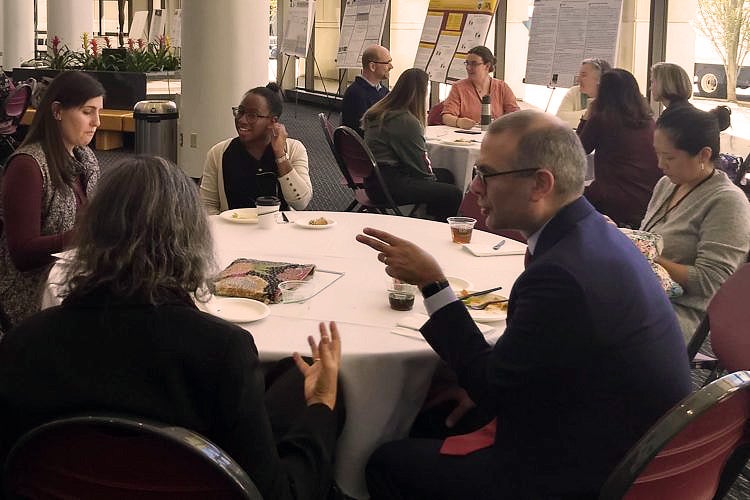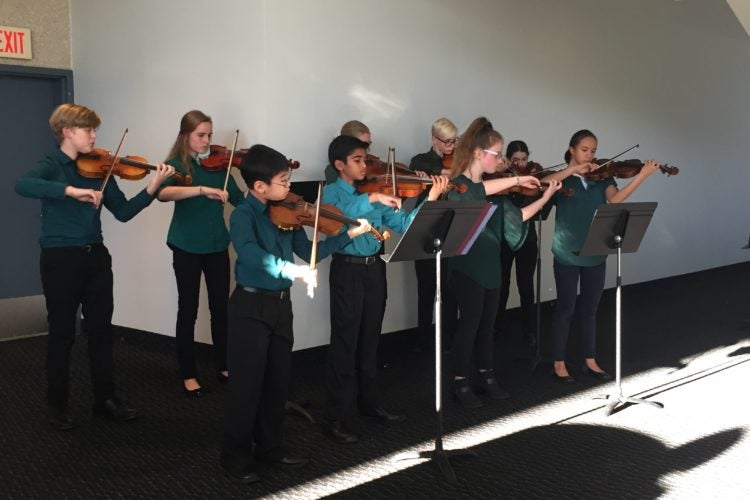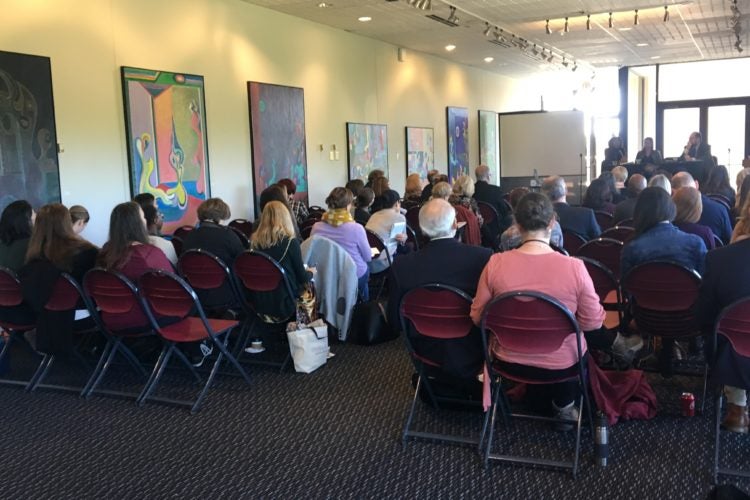When Diane Ruggiero, director of the Alexandria, Va., Office of the Arts, installed artworks on the sidewalks of the small city just south of Washington, D.C., she turned to her research director with a question: How can we measure the art’s impact?
As she recounted at a recent symposium, finding the answer was important because the display was a new taxpayer-funded effort whose expense Ruggiero’s office would need to justify. In the end, though, city decision-makers decided on a metric that was easily measurable—the number of artworks on display—but failed to provide the information needed to answer her question.
In fact, there could have been ways to measure impact: Did people notice the art? Had passersby stopped to look at it? Had they engaged in conversations about the display? Did residents’ pride in their city increase? But those indicators are more difficult to measure—and doing so requires more resources.
Ruggiero’s story illustrates some of the challenges facing arts research and was a familiar kind of tale to many attendees at the symposium, which examined research into arts education. Held at George Mason University last October, the conference was called Making Connections for Arts Education Research, Policy, and Practice. It was part of an effort by the National Endowment for the Arts (NEA) to develop insights to support the goal “that every child will have access to arts education,” as Ayanna N. Hudson, the NEA’s director of arts education, put it.
At a time when equity is on the minds of many educators and policymakers, she noted, the children most deprived of a sound arts education are “primarily kids from underserved communities, primarily kids of color.” A major reason for this unlevel playing field is the sense that arts is an extra, said Steven John Holochwost, principal and director of research for youth & families at the consulting firm WolfBrown.” The notion that arts education is different from education is a strange thing—but the fact is that this is where we are,” he said. This is especially troubling, he said later, because “the expansion of arts education to all children could help buffer the effects of poverty.”
At the symposium, many agreed that new and promising avenues of research are opening up that could build understanding of the value of arts education. A number of the studies have found links between hands-on arts learning experiences and a range of social and emotional skills.

For example, Kim Sheridan, associate professor of educational psychology, described an ongoing research project that has, so far, identified arts education as being particularly effective in building “agency.” This is a key social and emotional learning concept that encompasses the ability to define a problem, see an opportunity and create a solution, she said. Interestingly, though, agency is generally not studied in arts education.
Sheridan ran an experimental study centering on 36 fourth-grade children. Half were given a kit with step-by-step guidance; the other half worked in a museum “makerspace,” where children are encouraged to play and make something with circuits.
Both groups showed equal interest in the projects and an equal level of confidence in carrying out the projects, the study found. But when about half a dozen children were interviewed from each group, those in the makerspace were more likely to use two telling pieces of language: first-person pronouns to describe their working process and verbs focused on what they did. “These findings suggest while children find both approaches to making enjoyable, activities allowing exploration and individual design choices seem more useful and promote a greater sense of individual agency in making,” Sheridan concludes in her paper.
In a separate project, researchers studying the Early Bridges program for pre-schoolers at the Children’s Theatre Company in Minneapolis have found positive results for the participants’ language and social-emotional development. The program “uses storytelling and creative drama to help young children transform into storytellers of their own lives,” in the words of the company. Teachers rated the participants more collaborative in their play than a comparison group of children, according to Amanda Grenell, a doctoral student at the Center for Early Child Development at the University of Minnesota. “We know that it is definitely due to the program, not due to the fact that the kids are in a good pre-school,” she said.
Yet another study, a major piece of experimental research, found that relative to a control group, students in a music education program scored higher on standardized tests, earned better grades in English language arts and experienced improved “executive function,” the ability to plan, pay attention, switch tasks and do things that promote goal-directed behavior. It’s important to note, said WolfBrown’s Holochwost, the study’s lead author, that the participating students had been in the program for two to three years, meaning they had had a chance to sharpen their skills, put on performances and feel pride in the hard work of building difficult skills.

The research is described in Music Education, Academic Achievement, and Executive Functions, published in 2017 in the journal Psychology of Aesthetics, Creativity, and the Arts. “Our results suggest not only that the elimination of music from public education in the pursuit of higher academic test scores may be counterproductive, but that denying students music education may deprive them of an opportunity to build the basic cognitive and behavioral skills necessary for success in nearly every domain of school and life,” the report concludes.
The new body of arts education research contrasts with an older “either-or” debate about whether the goal of arts education is to teach technical skills like painting or playing a musical instrument—or, to improve academics. The intense interest in social and emotional learning, a composite concept of ideas drawn from psychology, learning theory and development, provides an “opening” to broaden the discussion about the value of a high-quality arts education, said Kenneth Elpus, associate professor of music education at the University of Maryland.
This more expansive view was reflected in a Wallace-commissioned literature review, Arts Education Through the Lens of ESSA, which found studies showing benefits from arts education not just in arts skills and academics but also in areas including social and emotional learning, and “processes,” a word for critical thinking. What’s more, the effects were robust enough to put them at the 75th percentile of 70 studies encompassing reading, math and science. Put another way, nearly three quarters of activities examined in those non-arts areas had lower levels of positive effects than the disciplinary approaches to arts education that were the subject of studies.
Moreover, arts learning can drive future engagement in the arts, according to an evaluation, Designing for Engagement: The Experience of Tweens in the Boys & Girls Clubs’ Youth Arts Initiative, which found high-quality arts programs created “sparks” that led to enrollment in more advanced classes.
Researchers are also widening their range of inquiry on arts education into realms including neuroscience, where new studies examining the impact of arts education on the developing brain are underway, Holochwost said.
Outcomes were not the only area that panelists pointed to as being ripe for further investigation.
Implementation research—that is, research on what makes for high-quality instruction—is crucial for improving arts teaching practices, said Elpus, noting that “the work of figuring out what good music education looks like is still in its infancy.” Laura Annunziata, who leads arts education programs at Wolf Trap, the Virginia-based performance venue within a national park, agreed, observing that many of those running arts programs are looking for guidance on how to structure the programs in ways that benefit children.
Mary Dell’Erba is senior project manager of the Arts Education Partnership, a national coalition of education, arts, government and other organizations dedicated to making high-quality arts education accessible to all U.S. students. She asked whether arts education should “seek to help improve practice, demonstrate outcomes, or both?”
Regardless of the answer, one area that could use more investigation is access to arts education; knowing more about it is essential to identifying needs and opportunities and making the case for improvements. “Good descriptive work is really important,” the NEA’s Hudson said. “What if we knew who had access in every single state and every single city in the country—just imagine what we could do on race, ethnicity, graduation rates.” Indeed, organizations like Big Thought, a nonprofit that promotes arts programming for young people in Dallas, have demonstrated that using data to map where arts education is—and is not—can be a powerful stimulus for action, as Revitalizing Arts Education Through Community-Wide Coordination recounts.
The NEA is currently working with the Education Commission of the States, which houses the Arts Education Partnership, to develop data guides and communication tools so that states and communities can extract data about arts education, according to Hudson.


The conference was a project of the multidisciplinary Mason Arts Research Center, which focuses on arts engagement, child development and education. It is part of the NEA’s Research Labs program, an effort by the NEA’s research division to establish regional labs to be a resource for the endowment. Sunil Iyengar, the NEA’s director of research, noted that one way out of the outcomes quandary was to distinguish between the kind of program assessments that seek to determine what benefits—or “value”—accrue from a specific approach to arts education, and more general research that lays the groundwork for how to think about value.
For Iyengar, the biggest takeaway from the conference was the importance of implementation research, given that the quality of arts education matters as much for creating benefits as access to it. The conference, he said after the meeting ended, suggested to him “that we need to employ the same level of rigor and attentiveness to understand program elements—what comprises a successful arts education, and for whom—as we bring to questions about outcomes and impacts for youth development, the 21st century workforce, or other domains.”
Lucas Held, Wallace’s director of communications, took part in the conference as a member of the Policy and Practitioner panel.




